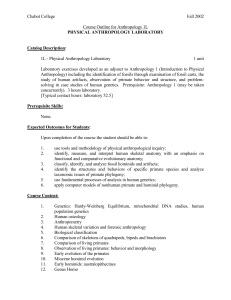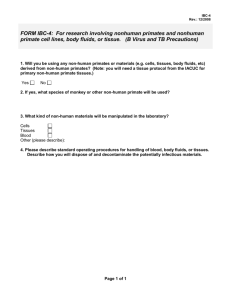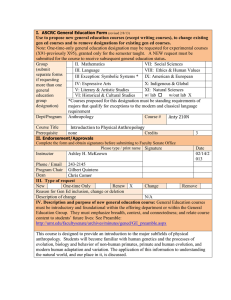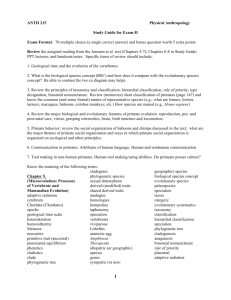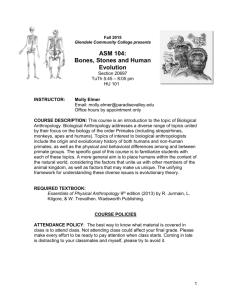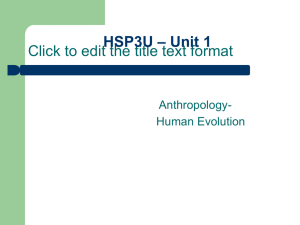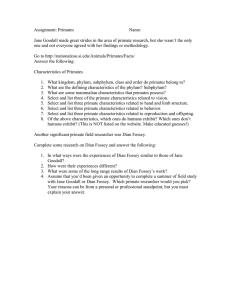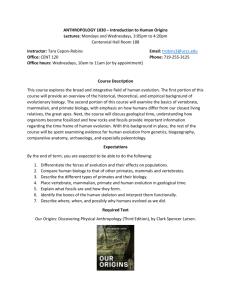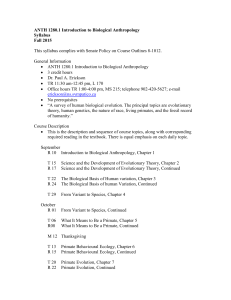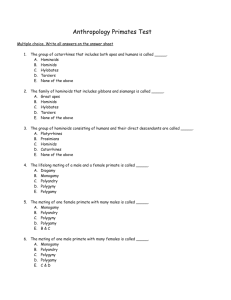ANTHROLAB-A.DOLAN
advertisement
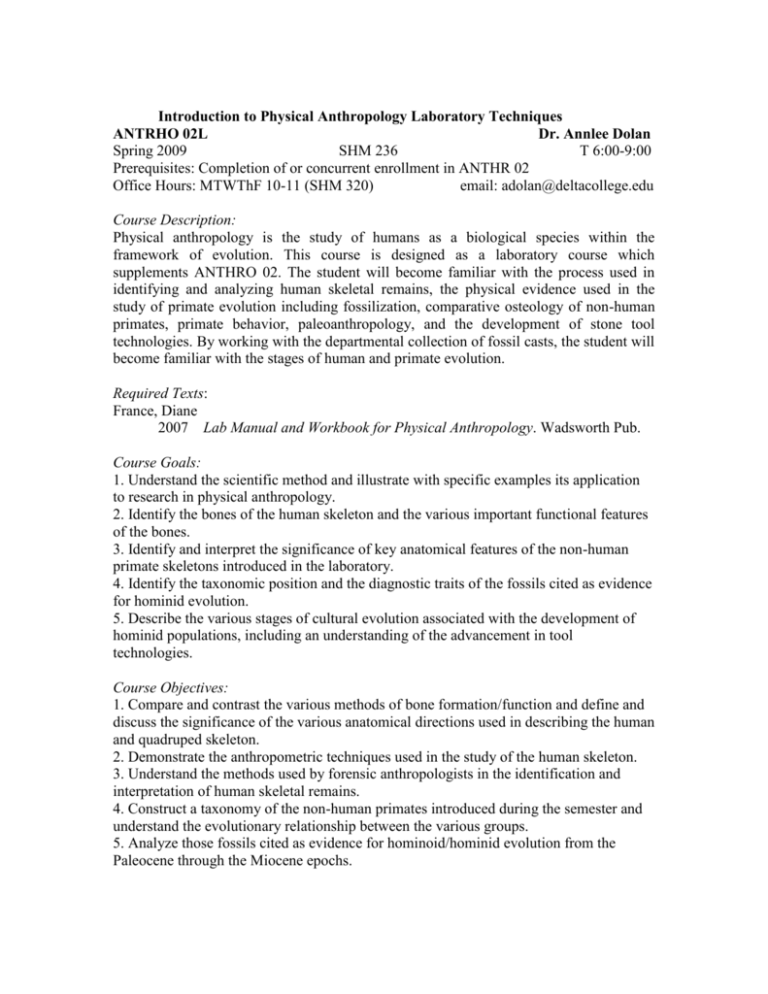
Introduction to Physical Anthropology Laboratory Techniques ANTRHO 02L Dr. Annlee Dolan Spring 2009 SHM 236 T 6:00-9:00 Prerequisites: Completion of or concurrent enrollment in ANTHR 02 Office Hours: MTWThF 10-11 (SHM 320) email: adolan@deltacollege.edu Course Description: Physical anthropology is the study of humans as a biological species within the framework of evolution. This course is designed as a laboratory course which supplements ANTHRO 02. The student will become familiar with the process used in identifying and analyzing human skeletal remains, the physical evidence used in the study of primate evolution including fossilization, comparative osteology of non-human primates, primate behavior, paleoanthropology, and the development of stone tool technologies. By working with the departmental collection of fossil casts, the student will become familiar with the stages of human and primate evolution. Required Texts: France, Diane 2007 Lab Manual and Workbook for Physical Anthropology. Wadsworth Pub. Course Goals: 1. Understand the scientific method and illustrate with specific examples its application to research in physical anthropology. 2. Identify the bones of the human skeleton and the various important functional features of the bones. 3. Identify and interpret the significance of key anatomical features of the non-human primate skeletons introduced in the laboratory. 4. Identify the taxonomic position and the diagnostic traits of the fossils cited as evidence for hominid evolution. 5. Describe the various stages of cultural evolution associated with the development of hominid populations, including an understanding of the advancement in tool technologies. Course Objectives: 1. Compare and contrast the various methods of bone formation/function and define and discuss the significance of the various anatomical directions used in describing the human and quadruped skeleton. 2. Demonstrate the anthropometric techniques used in the study of the human skeleton. 3. Understand the methods used by forensic anthropologists in the identification and interpretation of human skeletal remains. 4. Construct a taxonomy of the non-human primates introduced during the semester and understand the evolutionary relationship between the various groups. 5. Analyze those fossils cited as evidence for hominoid/hominid evolution from the Paleocene through the Miocene epochs. Outline of Topics: 1. Introduction to working with Bones 2. Scientific Method 3. Human Osteology 4. Introduction to Forensics 5. Introduction to Anthropometry 6. Introduction to the Primates 7. Paleoanthropology Course Requirements: Class attendance is mandatory for participation in “In Class Assignments and Exercises.” In addition to attending class, you may need to participate in several laboratory demonstrations. You will be tested on material both from class and your reading assignments. Obligation of the Student: 1. It is your responsibility as a student to come to class prepared. If you have any questions or concerns about the course material, please come and see me during my office hours. 2. It is important to respect others who are attending class with you. Therefore it is unacceptable to arrive to class late, talk or disturb the class during the lecture. Cell phones must be turned off! 3. PLAGIARISM is a serious academic offense, which may result in a course grade of 0. Please ensure that you summarize all information from your sources in your own words and make sure that you do not imitate the sentence structure of your source. Cheating may also result in a course grade of 0. Examinations and Assignments Lab Assignments Primate Zoo Assignment Test 1 Test 2 Final Exam 30% 10% 15% 15% 30% ALL exams and assignments are mandatory. Students must be on time for examsNo excuses! There will be no make-up exams so please make arrangements to be here on time! All students must write the final exam. Useful Resources: You may be unfamiliar with some of the medical terminology that appears in the texts. If so, please consult the online Medline dictionary provided by the US Library of Medicine: http://www.nlm.nih.gov/medlineplus/mplusdictionary.html Measurements in your text are given using the metric system. For conversion to the imperial system please see: http://www.valuecreatedreview.com/convert.htm Course Schedule: Jan 13 Introduction to Physical Anthropology, The Human Body, Bone and Anatomical Directions, Joints (Pp. 59-65) Jan 20 The Appendicular Skeleton: Arms and Legs (Pp. 77-86) Jan 27 Axial Skeleton (Pp. 72-77) Feb 3 Skull and Teeth (Pp. 65-72) Feb 10 Biological Sex, Age at Death (93-106, 279-301) Feb 17 Stature, Bone Pathologies, Traumas and cultural practices that shape bone (313-314, 251-268) Feb 24 Test #1 Mar 3 Early Primate Evolution (Chapter 8) Mar 10 Strepsirhines vs. Haplorhines Mar 17 Great Apes (Chapter 9, continued) Mar 24 Comparing the Living Primates (Chapters 6 and 7) Mar 31 HOLIDAY- no class Apr 7 HOLIDAY- no class Apr 14 Test #2 Apr 21 Earliest Hominids and Australopithecines (Chapter 10) Apr 28 Homo habilis, Homo erectus (Chapter 11) May 5 Neandertals, Homo sapien sapiens (Chapter 11, continued) Primate Zoo Assignment Due! May 12 Mandatory Study Period

